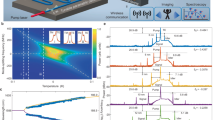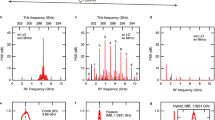Abstract
Tunable terahertz lasers are desirable in applications in sensing and spectroscopy because many biochemical species have strong spectral fingerprints at terahertz frequencies. Conventionally, the frequency of a laser is tuned in a similar manner to a stringed musical instrument, in which pitch is varied by changing the length of the string (the longitudinal component of the wave vector) and/or its tension (the refractive index). However, such methods are difficult to implement in terahertz semiconductor lasers because of their poor outcoupling efficiencies. Here, we demonstrate a novel tuning mechanism based on a unique ‘wire laser’ device for which the transverse dimension w is ≪λ. Placing a movable object close to the wire laser manipulates a large fraction of the waveguided mode propagating outside the cavity, thereby tuning its resonant frequency. Continuous single-mode redshift and blueshift tuning is demonstrated for the same device by using either a dielectric or metallic movable object. In combination, this enables a frequency tuning of ∼137 GHz (3.6%) from a single laser device at ∼3.8 THz.
This is a preview of subscription content, access via your institution
Access options
Subscribe to this journal
Receive 12 print issues and online access
$209.00 per year
only $17.42 per issue
Buy this article
- Purchase on Springer Link
- Instant access to full article PDF
Prices may be subject to local taxes which are calculated during checkout





Similar content being viewed by others
References
Mittleman, D. (ed.) Sensing with Terahertz Radiation (Springer, 2003).
Davies, A. G., Linfield, E. H. & Pepper, M. The terahertz gap: the generation of far-infrared radiation and its applications. Phil. Trans. R. Soc. Lond. A 362, 195–414 (2004).
Siegel, P. H. Terahertz technology. IEEE Trans. Microwave Theory Tech. 50, 910–928 (2002).
Tonouchi, M. Cutting-edge terahertz technology. Nature Photon. 1, 97–105 (2007).
Lee, M. & Wanke, M. C. Searching for a solid-state terahertz technology. Science 316, 64–65 (2007).
Köhler, R. et al. Terahertz semiconductor–heterostructure laser. Nature 417, 156–159 (2002).
Williams, B. S. Terahertz quantum-cascade lasers. Nature Photon. 1, 517–525 (2007).
Lee, A. W. M., Qin, Q., Kumar, S., Hu, Q. & Reno, J. L. Frequency-tunable external cavity terahertz quantum cascade laser. In Conference on Lasers and Electro-Optics/International Quantum Electronics Conference. OSA Technical Digest (CD), paper CThH5 (Optical Society of America, 2009).
Kumar, S. et al. Surface-emitting distributed feedback terahertz quantum-cascade lasers in metal–metal waveguides. Opt. Express 15, 113–128 (2007).
Dunbar, L. A. et al. Small optical volume terahertz emitting microdisk quantum cascade lasers. Appl. Phys. Lett. 90, 141114 (2007).
Zhang, H. et al. Terahertz photonic crystal quantum cascade lasers. Opt. Express 15, 16818–16827 (2007).
Buus, J., Amann, M.-C. & Blumenthal, D. J. Tunable Laser Diodes and Related Optical Sources (John Wiley & Sons, 2005).
Orlova, E. E. et al. Antenna model for wire lasers. Phys. Rev. Lett. 96, 173904 (2006).
Xu, J. et al. Tunable THz quantum cascade lasers with an external cavity. Appl. Phys. Lett. 91, 121104 (2007).
Huang, M. C. Y., Zhou, Y. & Chang-Hasnain, C. J. A nanoelectromechanical tunable laser. Nature Photon. 2, 180–184 (2008).
Maulini, R. et al. External cavity quantum-cascade laser tunable from 8.2 to 10.4 μm using a gain element with a heterogeneous cascade. Appl. Phys. Lett. 88, 201113 (2006).
Amann, M.-C., Illek, S., Schanen, C. & Thulke, W. Tunable twin-guide laser: a novel laser diode with improved tuning performance. Appl. Phys. Lett. 54, 2532–2533 (1989).
Williams, B. S., Kumar, S., Callebaut, H., Hu, Q. & Reno, J. L. Terahertz quantum-cascade laser at λ ≈ 100 μm using metal waveguide for mode confinement. Appl. Phys. Lett. 83, 2124–2126 (2003).
Kohen, S., Williams, B. S. & Hu, Q. Electromagnetic modeling of terahertz quantum cascade laser waveguides and resonators. J. Appl. Phys. 97, 053106 (2005).
Hu, Q. et al. Resonant-phonon-assisted THz quantum-cascade lasers with metal–metal waveguides. Semicond. Sci. Technol. 20, S228–S236 (2005).
Adam, A. J. L. et al. Beam patterns of terahertz quantum cascade lasers with subwavelength cavity dimensions. Appl. Phys. Lett. 88, 151105 (2006).
Huang, M. H. et al. Room-temperature ultraviolet nanowire nanolasers. Science 292, 1897–1899 (2001).
Duan, X. et al. Single-nanowire electrically driven lasers. Nature 421, 241–245 (2003).
Zimmler, M. A. et al. Laser action in nanowires: observation of the transition from amplified spontaneous emission to laser oscillation. Appl. Phys. Lett. 93, 051101 (2008).
Williams, B. S., Kumar, S., Hu, Q. & Reno, J. L. Distributed-feedback terahertz quantum-cascade lasers with laterally corrugated metal waveguides. Opt. Lett. 30, 2909–2911 (2005).
Williams, B. S., Kumar, S., Hu, Q. & Reno, J. L. Operation of terahertz quantum-cascade lasers at 164 K in pulsed mode and at 117 K in continuous-wave mode. Opt. Express 13, 3331–3339 (2005).
Baumberger, T., Heslot, F. & Perrin, B. Crossover from creep to inertial motion in friction dynamics. Nature 367, 544–546 (1994).
Braun, O. M. & Naumovets, A. G. Nanotribology: microscopic mechanisms of friction. Surf. Sci. Rep. 60, 79–158 (2006).
Rupert, F. O. et al. Plasmon lasers at deep subwavelength scale. Nature 461, 629–632 (2009).
Mauro, C. et al. Amplification of terahertz radiation in quantum cascade structures. J. Appl. Phys. 102, 063101 (2007).
Acknowledgements
This work was supported by the Air Force Office of Scientific Research, National Aeronautics and Space Administration, and National Science Foundation. Sandia is a multiprogram laboratory operated by Sandia Corporation, a Lockheed Martin Company, for the United States Department of Energy under contract no. DE-AC04-94AL85000.
Author information
Authors and Affiliations
Corresponding author
Rights and permissions
About this article
Cite this article
Qin, Q., Williams, B., Kumar, S. et al. Tuning a terahertz wire laser. Nature Photon 3, 732–737 (2009). https://doi.org/10.1038/nphoton.2009.218
Received:
Accepted:
Published:
Issue Date:
DOI: https://doi.org/10.1038/nphoton.2009.218
This article is cited by
-
Coherent control of a high-orbital hole in a semiconductor quantum dot
Nature Nanotechnology (2023)
-
Coherent terahertz radiation with 2.8-octave tunability through chip-scale photomixed microresonator optical parametric oscillation
Nature Communications (2022)
-
Electrically pumped terahertz laser based on a topological insulator quantum dot array
Science China Physics, Mechanics & Astronomy (2021)
-
All-optical adaptive control of quantum cascade random lasers
Nature Communications (2020)
-
Phase-locked photonic wire lasers by π coupling
Nature Photonics (2019)



